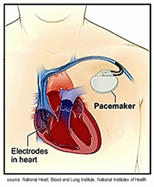Your Child’s Pacemaker
A pacemaker is a small machine that keeps your child’s heart beating properly. If your child’s heart is beating unevenly (irregularly), too quickly or too slowly, it sends an electrical signal to make your child’s heart beat at the right speed (pace). Most of the time, a pacemaker is put in (surgically implanted) in the upper chest.
About Pacemakers
Pacemakers have 2 parts:
- Generator. A small battery-powered machine that makes an electrical signal.
- Leads. Tiny wires that carry this information from the generator to your child’s heart. The wires are placed in the part of the heart (such as the atrium or right ventricle) that is not working properly.
Your child’s heart rhythm doctor (pediatric electrophysiologist) will talk with you about this procedure to see if it is right for your child. Some tests that can help check your child’s heart rhythm and function are: electrocardiogram, echocardiogram, MRI or CT scan.
There are many different types of pacemakers. Your child’s doctor will let you know which type is best for your child. All the pacemakers we use can be checked in over 150 countries. This means that your child will be able to travel safely in many places outside of the United States.
Placing the Pacemaker
Pacemaker leads (wires) are placed in the vein under the collarbone and guided into the heart. The tips of the wires are secured to specific spots on the inside of the heart. The pacemaker is usually placed under the collar bone or arm, though sometimes below the heart. Your child will get a special medicine (anesthesia) so he or she sleeps during the procedure.

Almost all children stay in the hospital overnight. Your child will get antibiotics and pain medicine. Your child will need to get a chest x-ray before going home. Your child’s doctor will discuss with you when your child may safely return to normal activities.
After the Procedure
Incision Care
We will place a sterile bandage (dressing) over your child’s incision after the procedure. This should stay on for 7 days (unless your child’s team says otherwise). After it comes off, please keep the incision dry and open to the air.
Device Testing
To make sure the pacemaker is working well, the leads are tested during and after the procedure. This test is called a device interrogation. We will perform a device interrogation every time your child comes in for an office visit.
Home Monitor
At home your child will stay connected to us through a home monitor. This home monitor links to your home network or cell phone. Every day it checks the device. It will alert your child’s medical team if there is a low battery, a problem with the leads or another problem. You can always send us your child’s data if you have any concerns or questions.
Identification Card
After the device is placed, your child will get a temporary identification card. This identification card includes important information such as:
- patient name
- states where the device is available
- serial number/s of the device
- name and phone number of the doctor that put in the device
A permanent card will be sent to you in the mail. This card should always be carried by you or your child. You may need it for other doctor visits and for security screening including airport detectors.
Follow-up Visits
We will schedule your child for a follow-up visit 1-2 weeks after the procedure. This is to check the incision and leads. Once the leads settle in (mature) and the incision heals, your child’s follow up visits will be about every 6 months.
Please tell your child’s doctor that your child uses a pacemaker before scheduling other medical procedures or surgeries.
We welcome your questions and concerns.
Please let us know how we can best support your child and family.
© NYU Langone Health. All rights reserved. Reviewed for health literacy. This information is not intended as a substitute for professional medical care. Always follow your health care provider's instructions.
Created in partnership with families and expertise from our Sala Institute for Child and Family Centered Care